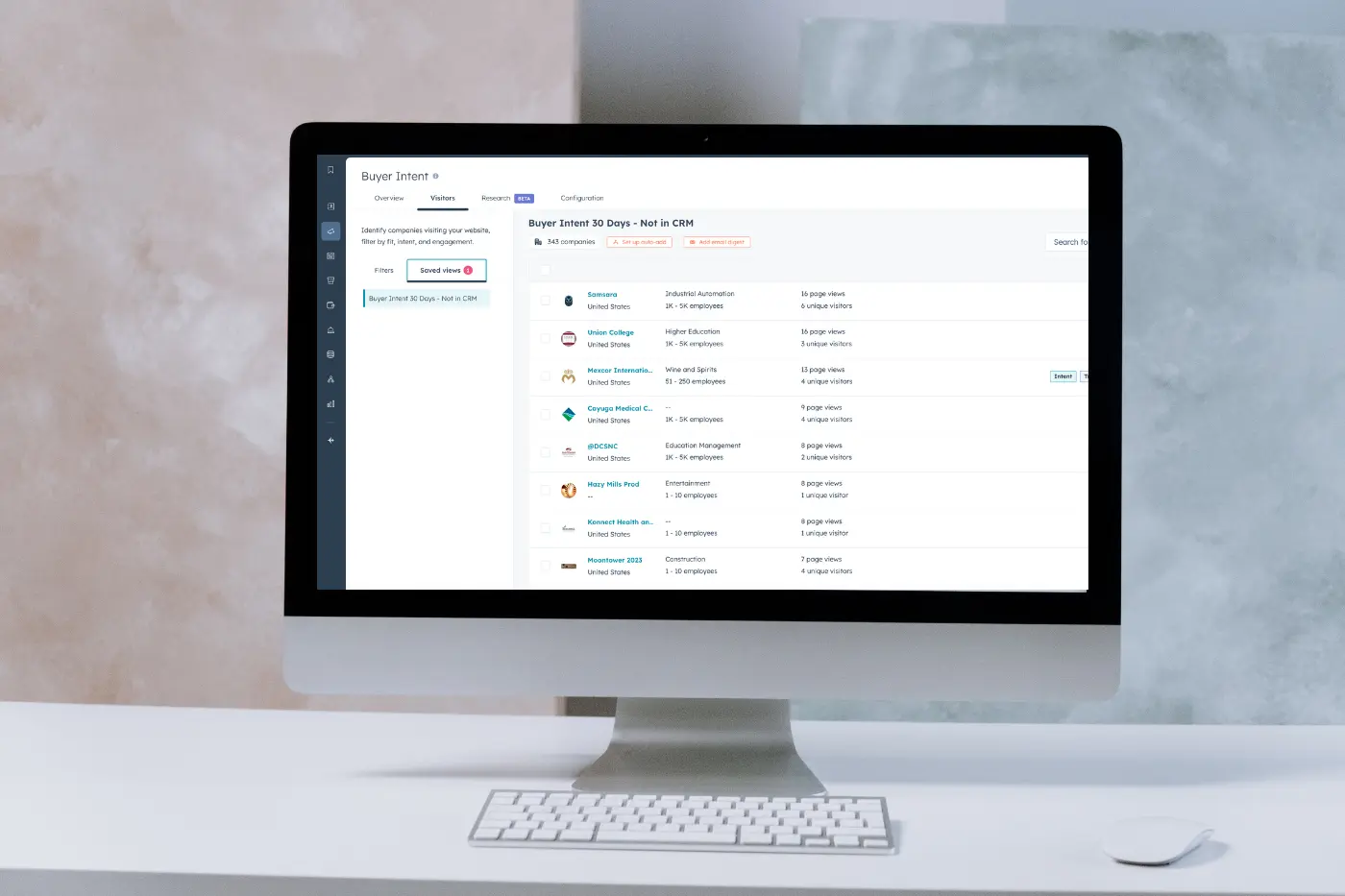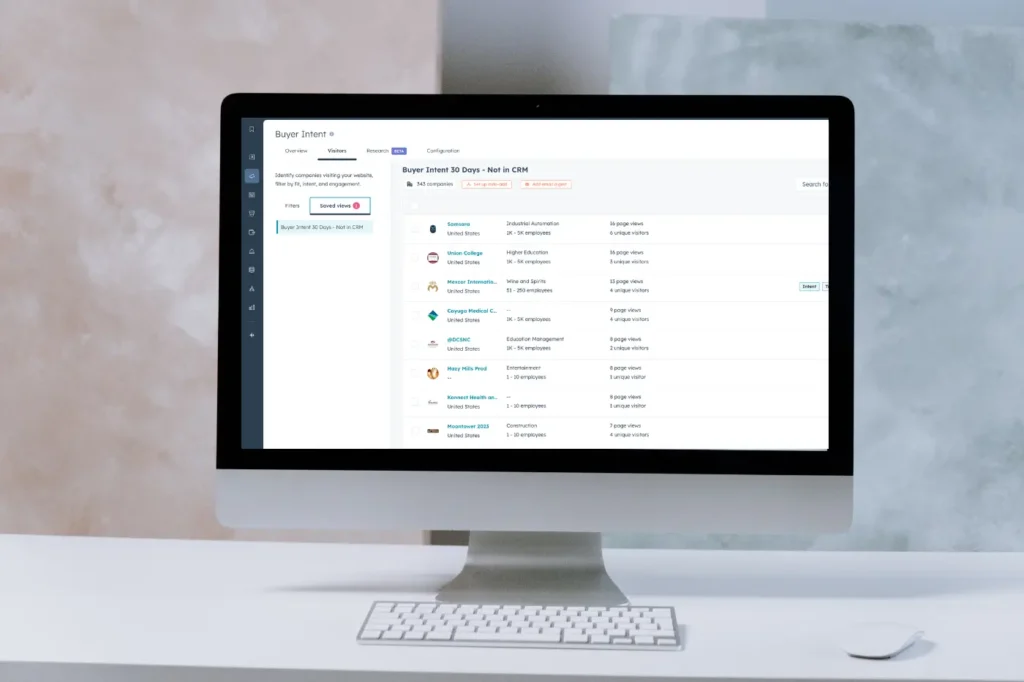Let’s be candid: prospecting can be kind of… awful. It’s time-consuming and often feels like throwing spaghetti at the wall, hoping something sticks. If you’re looking for a new, much more reliable strategy to try, let’s look at how to use HubSpot Buyer Intent for prospecting.
Sales teams spend countless hours chasing leads that go nowhere, while marketing teams struggle to connect their efforts with tangible sales outcomes. 42% of salespeople rank prospecting as the hardest part of their job – even harder than closing deals! [2]
HubSpot’s Buyer Intent tool can help you actually pinpoint the prospects who are already interested in what you’re selling. This article is your step-by-step playbook for using HubSpot’s buyer intent data and two strategic outreach techniques to help you prospect smarter, faster, and get better results.
How to Use HubSpot Buyer Intent for Prospecting
First thing’s first: your Buyer Intent tool has to be correctly set up and configured with your target markets, buyer intent signals, and research intent signals. If you haven’t set up that tool yet, read this article first. Follow those steps to get everything set up for sales and marketing purposes before you rely on it for prospecting.
Read our in-depth guide to setting up your HubSpot Buyer Intent tool here.
Once you’re all set up, HubSpot’s Buyer Intent features offer two primary ways to enhance your prospecting efforts: targeting new companies and confirming interest from existing ones.
Use Intent Signals to Find New Company Targets
Your ideal customer is actively researching solutions just like yours. They’re visiting competitor websites, downloading relevant content, and searching for keywords related to your industry.
HubSpot’s Buyer Intent data surfaces these signals, giving you major insight into companies exhibiting at least some purchase intent, even if they haven’t interacted with your sales team directly. This allows you to focus your sales efforts on the companies most likely to convert, dramatically improving your efficiency. By analyzing website visits, content downloads, and relevant keyword searches, you can identify companies that are actively in the market for your offerings.
This is especially valuable for targeting new accounts and expanding your reach within your Target Markets and Total Addressable Market (TAM). For example, a SaaS company selling project management software could use the “research intent” function to identify companies researching keywords like “agile project management tools” or visiting competitor websites like Asana or Trello.
You can find companies that are even warmer, too. Using HubSpot’s Target Market filter to view the companies that have actually visited your website can help you connect with buyers at companies who are aware of your brand and solution – even if you didn’t know it.
Use Intent Signals to Confirm Interest From Existing Targets
Buyer intent isn’t just for finding new leads. It’s also incredibly powerful for prioritizing your existing prospects.
Let’s say you have a list of companies you’ve been nurturing. By analyzing their intent signals – such as increased website activity, specific page views (like your pricing page), or research intent signals – you can determine who’s genuinely ready to move forward. This allows you to focus your time and resources on the hottest leads, increasing your chances of closing deals and maximizing your conversion rate.
This focused approach is key to accelerating the sales cycle and improving your overall sales performance. For example, suppose a prospect who previously downloaded a whitepaper suddenly starts visiting your pricing page multiple times and clicking through your product demo page. In that case, this signals pretty strong buying intent. A case study highlighted by Demandbase showed a 30% increase in deal close rates when sales teams prioritized prospects exhibiting high intent.
Practically, your marketing team can set up custom HubSpot sales enablement workflows to trigger notifications for contact owners when existing contacts engage with key bottom-of-the-funnel content, or when the buyer intent tool sees high-priority companies hit key pages of your website. –
Try Social Selling on LinkedIn Without Being Annoying
Once you’ve identified high-intent prospects, social selling on LinkedIn becomes significantly more effective. Instead of sending generic connection requests or pitching your product outright, you can tailor your outreach based on their demonstrated interests.
You’ll want to head over to LinkedIn and look up the company from your Buyer Intent data. If you have LinkedIn Sales Accelerator, you can use that tool to look up the right people at the company within that tool easily. Without Sales Accelerator, you can still look folks up, but it’s a bit more manual. Once you’re on the Company Page, click the “People” tab. Use the search bar to find the people with job titles that most closely match your buyer persona, and start making connections.
No matter how you connect, don’t try to book a meeting immediately – and don’t promote yourself or your company right out of the gate, either.
For example, suppose a prospect from Company ABC has been researching a specific topic related to your solution. In that case, you can look up your likely buyers through their LinkedIn page, then initiate a conversation by sharing a relevant article or offering valuable insights. This approach positions you as a helpful resource rather than a pushy salesperson, building trust and fostering genuine engagement.
This targeted approach drastically improves response rates and connection acceptance rates. For instance, if a prospect shows intent around “data security,” sharing an article about best practices instead of immediately pitching your cybersecurity software builds credibility.
Social media selling works because it offers potential buyers the knowledge and education they’re already seeking. It gives them access to someone (you) who is clearly knowledgeable on the topic and can answer any questions they have along their path of learning and general position in the buyer’s journey. This helps you build a unique connection that fosters brand loyalty and builds trust long before the actual first meeting begins.
For more tips on social selling, check out this guide.
Try Outbound Outreach With a Sales Engagement Tool
HubSpot is all about Inbound sales and marketing, and there’s no doubt that inbound deals can move a lot faster than prospects captured through cold outreach. However, outbound outreach, when done right, remains a powerful tool – especially when you use Buyer Intent to find folks that are already in the market for your products and solutions. A sales engagement platform, especially one integrated with HubSpot, supercharges your efforts.
Apollo.io is one such tool. It’s a data intelligence and outbound prospecting platform that integrates with HubSpot to help unify your outbound and inbound strategies. It’s designed to help sales teams discover potential leads, enrich data about leads you already have, and automate your outbound outreach.
Apollo has a fairly extensive database of contact information, plus email sequencing tools and AI-driven insights. You can search the Apollo database for contacts that fit your buyer personas at the companies that were revealed in the buyer intent tool, and add those contacts to an automated outbound sequence to give them more information and nurture them to the next step in their buyer’s journey.
There’s a right way and a wrong way to do outbound prospecting. Here’s how to avoid being just another spammer:
Tip 1: Complete your inbox setup and ramp up
Don’t blast out thousands of emails on day one. Start slow, monitor your sender reputation, and gradually increase your sending volume.
A sudden spike in email activity can trigger spam filters and damage your deliverability. A good starting point is to send a small batch of emails (e.g., 50-100) and analyze the metrics. For instance, if open rates are low, experiment with subject lines and preheader text. A study by Return Path showed that sending too many emails too quickly can decrease deliverability by up to 20%.
Really, you just need to use the built-in warm-up tools in solutions like Apollo to slowly increase sending volume and avoid getting flagged as spam. The slow ramp-up period for new email sending domains and recently connected inboxes in tools like Apollo is intentional. Just be aware that this means, depending on how many prospects you enroll into any given sequence, it’ll take a lot more time to complete your first outreach campaign because you’ll be limited to about 10 emails a day for the first few weeks.
Tip 2: Provide one-click unsubscribe
Make it easy for people to opt out. This not only respects their preferences but also improves your sender reputation by reducing spam complaints. A clear and easily accessible unsubscribe link is crucial for compliance with regulations like GDPR and CAN-SPAM. Making unsubscribing difficult can lead to increased spam complaints and damage your sender reputation.
Tip 3: Have a good (but not unbelievable) offer or hook
Your offer should be compelling and relevant to the recipient’s interests, based on their buyer intent data. Avoid over-the-top promises that sound too good to be true. Focus on providing genuine value.
For example, if a prospect is researching “content marketing strategies,” offering a free content audit is more effective than promising a 10x ROI overnight. A study by HubSpot found that offering personalized content based on buyer intent increases engagement rates by 42%. Practically, segment your audience based on intent data and tailor your offers accordingly.
Give More Than You Ask For: Deposits vs Withdrawals
Think of every interaction with a prospect as either a deposit or a withdrawal. Asking for a meeting or a demo is a big withdrawal. Sharing valuable content, offering helpful insights, or connecting them with relevant resources is a deposit.
By consistently making deposits – especially those aligned with a prospect’s demonstrated buyer intent – you build trust and establish yourself as a valuable resource. This makes those eventual withdrawals much more likely to be accepted.
For example, if a prospect demonstrates interest in “key account management software,” sharing a relevant blog post to help them understand or solve their problem is a deposit. Later, inviting them to a webinar on advanced KAM strategy is a small withdrawal, but the actual educational webinar is a big deposit!
Nielsen research shows that 70% of consumers prefer getting to know a company via content rather than ads. Build a content library specifically for nurturing leads based on their demonstrated buyer intent, and put it to use in your nurture sequences and outreach strategies.
Strategic Prospecting & Sales Enablement to Get it Done
Strategic prospecting, fueled by buyer intent data, is the key to unlocking sustainable sales growth. By aligning your sales and marketing teams around a data-driven approach, you can significantly improve your efficiency, conversion rates, and overall sales performance. Companies that use buyer intent data are 2.5 times more likely to exceed their sales targets! [5]
Something like 80% of B2B sales interactions will occur through digital channels [6]. Buyer intent data is no longer a nice-to-have; it’s a necessity for staying competitive. HubSpot provides the tools to unlock this invaluable data and transform your prospecting from a guessing game into a precise, revenue-generating engine. Remember to prioritize data quality (clean CRM data is essential), start small and scale gradually, and continuously test and optimize your approach.
By combining the power of HubSpot’s Buyer Intent features with the prospecting strategies here, you can significantly improve your lead generation, conversion rates, and overall sales performance. Don’t just wait for leads to come to you – proactively identify and engage with the prospects who are already showing interest. The future of prospecting is intent-driven, and with HubSpot, you have the key to unlock its full potential.
Want to dive deeper? See how the right tools + the right strategy helped this company build a full suite of GTM assets and tactics to grow their pipeline.




